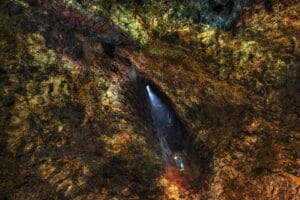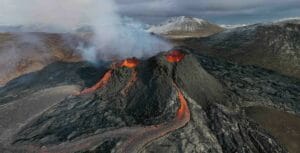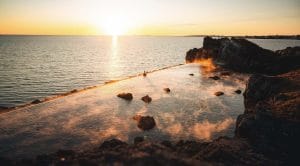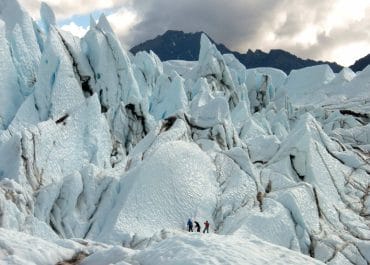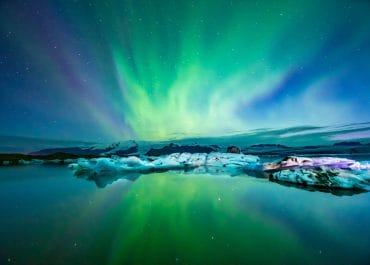Looking for some adrenaline-rush inducing hiking trails in Iceland? Fimmvörðuháls hike or Fimm hike has it all! This is a short 25 km hiking trail that begins at Skogafoss watefall and ends at Basar Hut in Thorsmork. The hike is often done as an extension to Laugavegur hike. One of the most thrilling day hikes in Iceland, this trail offers a chance to view a diversity of flora and fauna. It is located on the south coast of Iceland and starts at one of the most famous tourist stops in Iceland, Skógafoss. You get an opportunity to walk past over 25 waterfalls to grassy tundra; across a plateau home to two of the world’s gigantic volcanoes.

About Fimmvörðuháls
Fimmvörðuháls is a route between the glaciers Eyjafjallajökull and Mýrdalsjökull in southern Iceland. The area between Skogar and Thorsmork goes through this route and is one of the most popular hiking routes in the region. This trail takes you through almost every terrain that Iceland has to offer. Explore from the lush terrain of waterfalls to lava fields and then pass through the glaciers. The hike is challenging as well as a rewarding experience. This hiking trail is ideal for both avid hikers and the challengers. The trail is located in south Iceland. It is popular for tourists and has few landmarks such as the Skogafoss waterfall. However, some sites remain remote and it is advised to keep you equipped with all the essential gear.

Some Facts about Fimmvörðuháls Hike
This is a challenging trail to be finished in a day if you move fast enough and require a high fitness level. Many people like to take it slow and take about 2 days to finish the hike since the trail is difficult and it’s better to be safe than sorry. Fimmvörðuháls trail takes about 12-14 hours to complete and covers approximately 25 km. It is open during June, July, and August. Experienced hikers can go hiking without a guide during these months. The maximum elevation of the hike is 1400 m. Even though the trail is accessible in summers, expect a temperature of around 5o C. You can begin the trail from either direction. If you are continuing further from Laugavegur hike then you will find that Fimmvörðuháls hike is comparatively harder and a lot more thrilling as compared to the previous one. You will be walking on a trail that goes between the two glaciers – Eyjafjallajökull and Mýrdalsjökull which house volcanoes beneath their ice caps. A rather thrilling experience for both experienced and beginner hikers.

Pros and Cons of Hiking in the Region
A chance to view the scenic landscape is the advantage of Fimmvörðuháls hike followed by accommodation arrangements, and adrenaline-inducing thrill. There are very few discomforting factors that can come along the way if it is your first-time hiking and you do know what to expect. The weather is generally pleasant but can change at any moment from warm and sunny to rainy. Bad weather conditions can result in loss of visibility.

Know the Trail Route
This is a short one to two days trail between Skogafoss and Thorsmork. It is a 25 km long trail. This trail has three distinct sections, each of which is geographically unique:
- Skoga River to the Fimmvörðuháls mountain hut
- Pass between Eyjafjallajökull and Mýrdalsjökull glaciers
- Goðaland, the area that leads to Thorsmork
The trail ends in Thorsmork, a region of the river valley accessible by road from the Ring Road and with accommodations and camping sites. The road follows the river valley back to the Ring Road on a gravel road with multiple river crossings.

Skoga River
The first section of this hike is marked by 25 waterfalls while following along the eastern bank of Skoga River. You will be tempted to stop and intake the view of each waterfall. The first section of the trail is set amidst a dramatic backdrop of the North Atlantic Ocean and rocky terrains.

Volcanic Plateau
A one-third way into the trail, you cross the Skoga river over a narrow bridge and enter a volcanic region situated between the two glaciers. The landscape, thus, changes from a lush river canyon to barren volcanic rock with scattered patches of vegetation and moss. The trail inclines for a few kilometers until you reach the hut. In the route, there are chances of you coming across Icelandic sheep, feeding in the fields for the summer.
Then you cross a few snowfields until you reach the pass, the site that has the world’s most interesting recent volcanic history. Across the snowfield, you come across two six-year-old mountains, Magni and Modi, with a trail, edged into red, crumbled lava rock.

Descent to Thorsmork
Once you leave the upper volcanic fields, you head north and then descend down to Thorsmork along the ridge with great scenery in both east and west directions. Thorsmork is named after Thor, the Norse god of thunder, and is filled with various mythological stories which you can explore and talk about while at the place. After the descent you enter onto a large, expansive plateau where you hike a kilometer before dropping down to Kossa River.

Alternate Hiking Routes and Variations
Following are some alternative routes to the Fimmvorouhals hike which you can choose from for your expedition:
- Round Trip from Skogafoss Waterfall: This scenic route does not include 12 hours of walking through difficult landscapes. Start from the Skogafoss, walk along the river until you cross the bridge, and then head back. It is about 16 km distance.
- Hvannargril Canyon: If you are looking for a more thrilling experience and ending the hike with a beautiful landscape, Hvannargril Canyon is an amazing variation on the hike. This is a difficult trail with steep drops and is suitable for more experienced hikers and hikers who have brought a professional hiking guide with them.
- Laugavegur Trail: Combine Laugavegur and Fimmvorouhals trails into a five-day hike. The former is known for its multi-colored mountains and dramatic scenery and has mountain huts along the way for accommodation.

How to Get to the Trailhead
Getting to the starting point of the trail from Reykjavik is pretty simple. It is a 2.5-hour drive from the capital city along the Route 1 south coast road. You will find a marked sign to Skogafoss camping ground where you can park the car. When coming back to the parking from Thorsmork take a bus to Seljalandsfoss and then another bus that takes you from Seljalandsfoss to Skogar.
The best time to go hiking in Iceland is from July to mid-September when the weather is at its best and the trails are clear of snow. However, the initial part of the season can turn out to be quite busy, and hence you may find crowded campsites and fully booked huts at arrival if you have not made prior reservations. If you are okay with the crowd then peak season is the best time for you to get on with the hike as the weather is clear most of the time, the scenery is flourishing at its best and you get plenty of chances and landscape to get some Insta-worthy snapshots. Although if you want a hike in a secluded arena, then the end of August to mid-September is the best time to make your reservations.

Accommodation
If you plan to make your hiking trip a two-day trek, you can get accommodation at Fimmvorouhal’s Mountain Hut which is located midway between Skogar and Thorsmork. This hut has dormitory-style accommodation with mattresses on the floor.
- It accommodates 16 people only and reservations are required to be done in advance.
- You will find necessities like a toilet and shower in the hut.
- A basic mattress is provided in the room so you will need a sleeping bag of your own for a more comfortable sleep.
- While fresh drinking water is available in the hut, there is no service for hot meals. You will get cooking equipment like gas, stove, and utensils to cook so bring along your raw material if you want to have hot meals.
- There are some basic things available to buy at the warden’s station like some crisps and chips, bottled drinks, alcohol, sanitary napkins and tampons, band-aids, etc.
- The hut at Thorsmork has a restaurant that serves hot meals so you can get something packed if you prefer.
If you decide to extend your hike to Skogar on a fluke then you can stay at the campsite but you will need a personal tent to do so. So, you can bring one along, just in case. The campsite will not have any access to cooking equipment from the hut hence stacking up a bit on packed food is a good idea for the day. If you are carrying your own equipment then you can get to cooking in your tent. While toilets are accessible to everyone, showers can only be used by campers with a fee.

Equipment and Gear
Hikers in any region, especially one like Iceland where weather gives no guarantee of being pleasant all the time, need to be fully prepared for every plausible scenario that they may face. Here is a list of basic items for you to check before you set out for the hike:
Clothing and Other Essentials:
- Waterproof jacket and trousers – lightweight and easy to carry
- Gloves and mittens
- Warm headgear like hats and beanie caps
- Hiking pants or shorts
- Hiking shoes and socks
- Complete body warmer set
- Insulated jackets and other warmer layer of clothes
- A set of comfortable clothes to sleep in
- Backpack – preferably 40L to 60L capacity
- Rain cover for backpack
- Toiletries like soap, shampoos, tissue, wet wipes, etc.
- Important gadgets like phone, tablets, camera, charging equipment and travel adapters
- Map and a Compass
- Pocket Knife
- Flashlight or a headlamp
- Trekking poles to serve as tent poles
Sleeping Arrangements
- Sleeping bag: A necessity if you are going to stay at the campsite and a plausible essential if you are going to stay in the huts. There are mattresses provided in the huts but you will still need a well-insulated sleeping bag made for hiking in extremely cold regions for proper sleep. Consider buying a variant that is graded for below freezing level temperatures.
- Inflatable sleeping pad: Even sleeping bags alone can be a bit hard to be a comfortable bed so consider keeping an inflatable sleeping pad with you.
- Pillow (optional)
- Tent: Campsites do not provide tents so you will need to bring your own. Since you will be doing things like cooking inside your tent, we suggest that you choose one with a large vestibule.
Cooking Equipment
Campers will not be provided cooking equipment from the hut so you need to bring a few basic things along, like a stove, gas (fuel), a lighter, cooking utensils, and spork (spoon + fork), a bowl, and a cup if you want to enjoy a hot meal on your hike.


